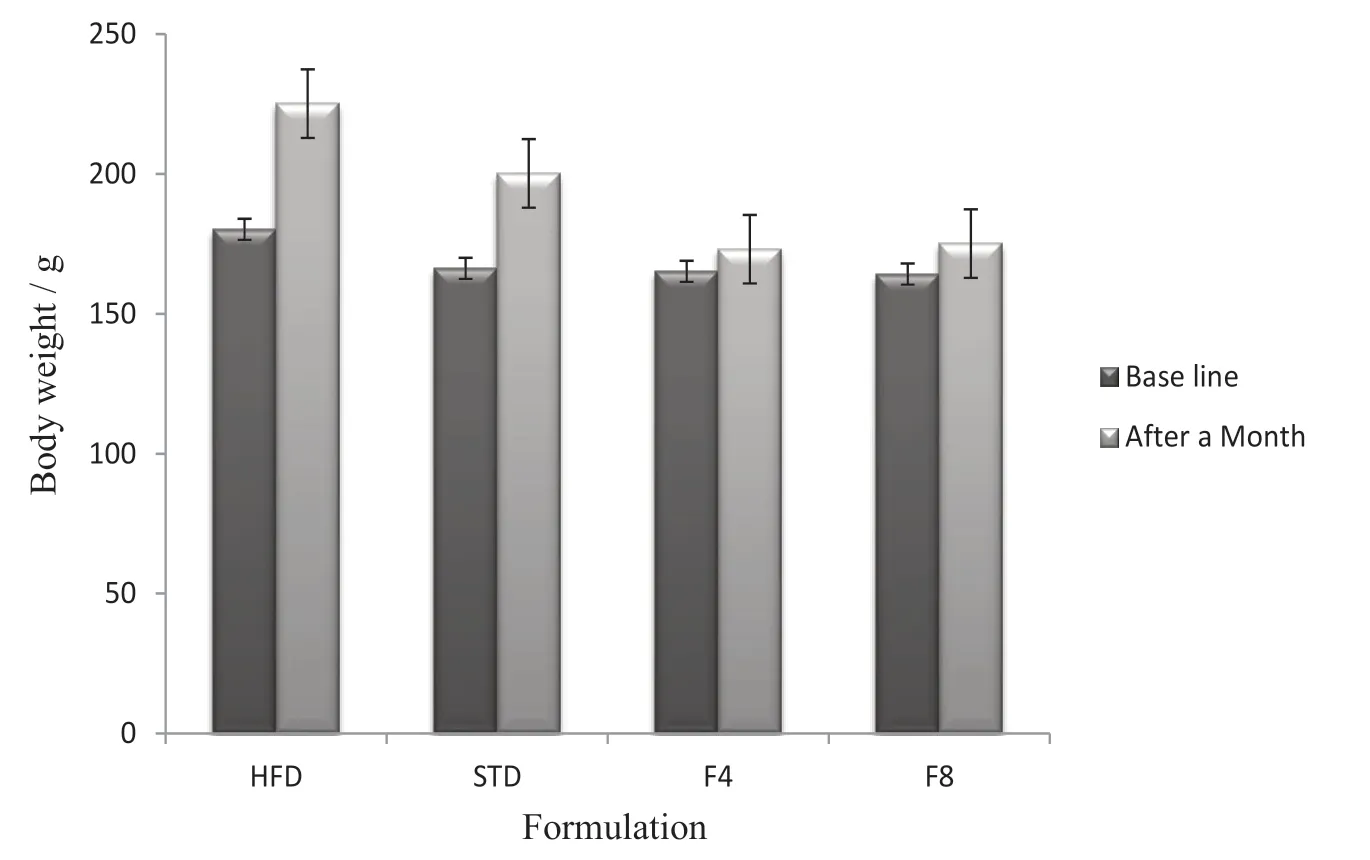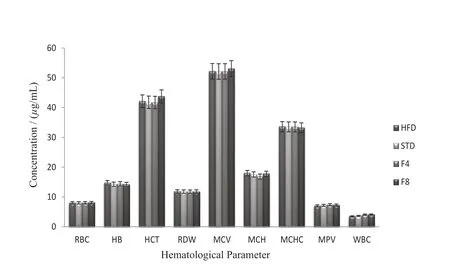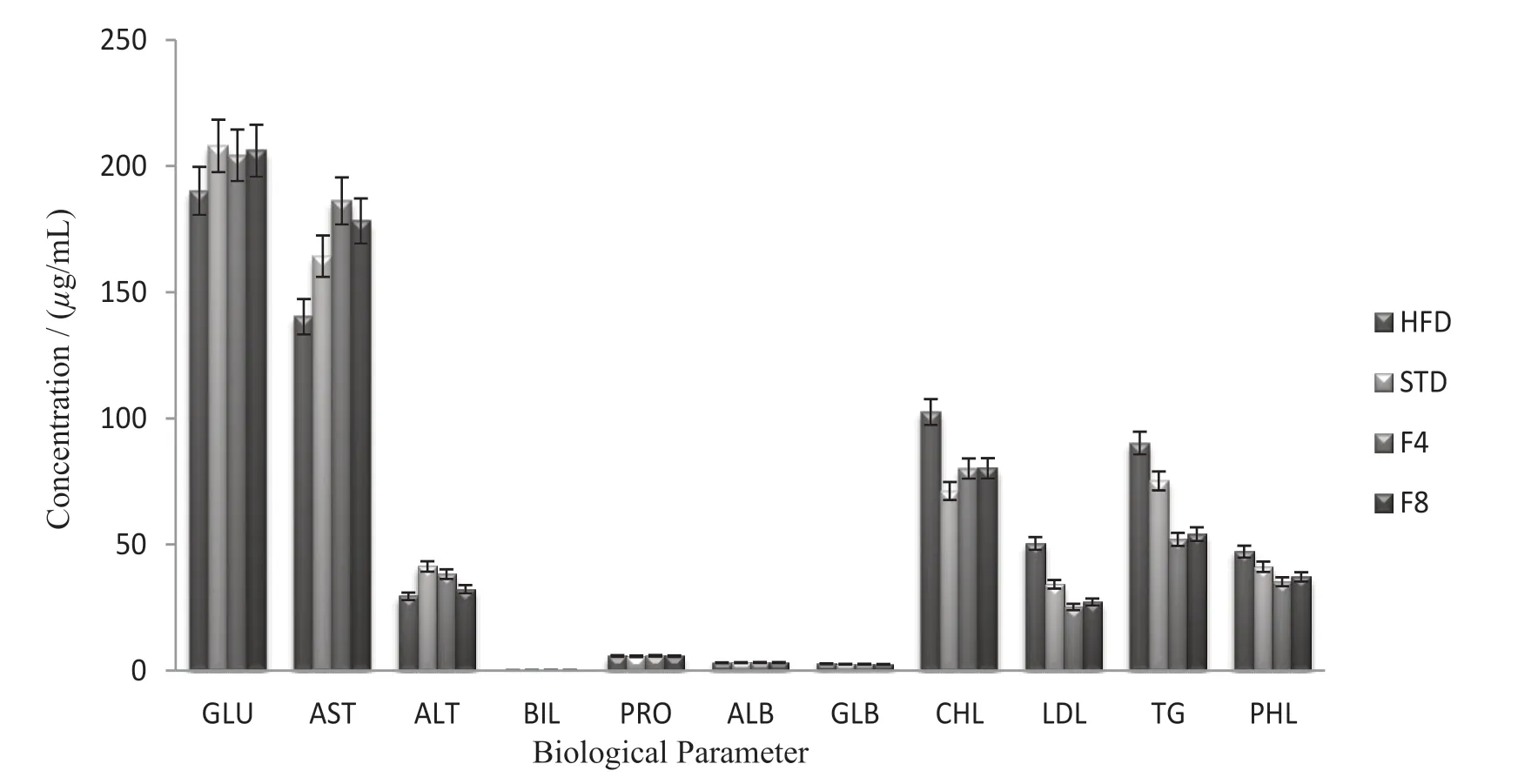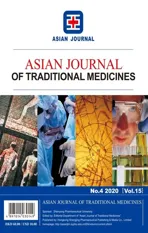Impact of polyherbal formulations MEF-4 and MEF-8 on high fat diet induced obesity in SD rats
2020-10-14VijayKumarSinghDebashishParamanickVikashSharmaShikhaYadav
Vijay Kumar Singh,Debashish Paramanick,Vikash Sharma,Shikha Yadav
School of medical and allied science,Galgotias University,Plot No.2,Yamuna Expy,Opposite,Buddha International Circuit,Sector 17A,Greater Noida,Uttar Pradesh 203201
Abstract As a traditional healing system of India,herbal medicines have been used as therapeutics over a long period of time.In the present study,polyherbal formulations MEF-4 and MEF-8 from two pharmacologically important plants,Camelia Sinensis(CS) and Citrus Aurantium(CA),were studied in vivo for their potential in reducing obesity and hyperlipidemia.These two formulations are different from each other in the manner that they contain two different polymers and that MEF-4 was prepared through cold extraction of CS and CI and MEF-8 was prepared through hot extraction method.Hyperlidemia leads to many complications like hypertension,stroke and heart attack.It also creates complications to the patients suffering from chronic disorders like diabetes and stress.The aim of the present investigation is to assess the effect of these two formulations on the possibility of reducing obesity.The rodents enlisted in hyperlipidemia had taken a high-fat diet for about 14 d.The hyperlipidemic rodents of 250 g were taken in the study,treated with standard eating regimen and high-fat eating regimen orally for 30 d.After treatment for 30 d,blood tests from the MEF-4/MEF-8/standard/vehicle were gathered and an impact on body weight,hematology and lipid profile was investigated.Statistical analysis showed there was a significant increase in cholesterol(CHL),low density lipoprotein (LDL),triglyceride (TG),phospholipids (PHL) change in the body weight of group I (HFD) and II(STD) as compared to group III (MEF-4) and group IV (MEF-8).The decline in triglyceride (P< 0.01) was also noted for MEF-8 when compared to control and standard.
Key words:polyhedral; hyperlipidemia; lipid profile; obesity
1 Introduction
Obesity is a metabolic disorder,becoming increasingly common all over the world.With the increase of body weight and the excessive deposition of fatty tissues,obesity becomes a risk factor for polygenic disease,high blood pressure,and cardiovascular disease.The decline of physical activity and the increase of energy intake (calories)promote weight gain,body fat storage and growth in a pathologic direction [1,2].Adipocyte,known as the adipose cell,is the significant part of the fat that’s referred to as loose connective tissue or fat tissue.It operates as an energy storage site in triglyceride [3].Fat plays a significant role in maintaining the level of free fatty acids and triglycerides in circulation.Analysis suggests that it is potential to reduce fat mass by reducing the adipose tissue mass instead of decreasing the adipocyte number [4].Lipid lowering medication,mainly statins and fabric acid derivatives,are widely used to control the increase of various blood lipid levels in patients with lipidaemia.Because of serious complications,these medications need to be used safely or avoided as much as possible [5].Evidence shows that tea and its catechins,particularly EGCG,reduce weight rather than fat and blood lipid level [6].Additionally,analysis reports suggest that PMF from orange,named hesperetin,will lower the danger of coronary cardiopathy by lowing blood lipid [7].In recent years,the development of lipid-lowering drugs or formulations from natural sources has become more and more important.Hence an attempt is made to develop a polyherbal formulation containing the extracts fromCameliasinensisandCitrus Aurantiumand to evaluate its anti-obesity effect [8].
2 Materials and methods
2.1 Plant materials collection and extraction
The plant materials used in the formulation were collected from an authorized raw drug dealer,Thanjavur,Tamilnadu,India,and properly authenticated with the help of the Pharmacognosy Department of Drug Testing Laboratory,CHARISM,SASTRA University,Thanjavur.Then the materials were dried in the shade and coarsely powdered with a mechanical grinder.Using 70% methanol as solvent,theCamellia sinensis(CS) leaves andCitrus Aurantium(CA) peel were extracted three times by soxhlet extraction method.The extracts were collected and concentrated under vacuum.The crude extracts obtained were stored in a refrigerator for further use.The two formulations were prepared by mixing the extracts with different polymers,as specified in Table 1.

Table 1 The ingredients of the polyherbal formulations of Methenolic Extracts Formulation-4 (MEF-4) and Methenolic Extracts Formulation-8 (MEF-8) under study
2.2 Drugs and chemicals
Cholesterol,casein and coline were purchased from Himedia Laboratories,Mumbai.The biochemical kits used for the estimations were brought from Merk Diagnostics Pvt.Ltd.,Mumbai,India.
2.3 Preliminary phytochemical analysis
A portion (2 g) of the polyherbal formulation was used for the preliminary phytochemical analysis,which includes tests for carbohydrates,glycosides,proteins,amino acids,alkaloids,phenols,flavonoids,phytosterols,fats,fixed oils,saponins,tannins and sugar with the methods of Trease and Harborne [9,10].
2.4 Experimental animals
Sprague-Dawley rats weighing 250 g were used as experimental animals and maintained in accordance with Institutional Animal Ethics Committee (IAEC) regulations and approved by Committee for the Purpose of Control and Supervision of Experiments on Animals (CPCSEA)(IAEC approval number:86/SASTRA/IAEC/RPP).
2.4.1 Induction of hyperlipidemia
The high fat diet (HFD) and Standard diet(STD) was prepared (Table 2) and administered for 2 weeks to all groups except the normal control group fed only with standard food.At the end of the 2th week,total cholesterol level in serum was estimated and the animals with lipid levels greater than 250 mg/dL was selected and regarded as hyperlipidemic rats [11,12].
2.4.2 Experimental design
The animals were grouped into 4 groups of 10 rats.
Group I:Control group receiving HFD as vehicle.
Group II:Control group receiving STD as vehicle.
Group III:Hyperlipidemic rats treated with MEF-4 250 mg/kg orally for 4 weeks.
Group IV:Hyperlipidemic rats treated with MEF-8 250 mg/kg orally for 8 weeks.
24 h after the administration,blood samples were collected from retro-orbital plexus,coagulated at room temperature,and then centrifuged at 3000 rpm for 10 min.The serum was separated and used for biochemical estimation.
2.4.3 Estimation of serum lipid profile
Serum lipid profile was estimated using standard protocols [12,13].
2.5 Statistical Analysis
Experiment was repeated three times and the results were expressed by mean ± SD.a,P<0.001; b,P< 0.01 between the groups were analyzed by Analysis of Variance (ANOVA) through Bonferroni’s post test using Graph Pad Prism 5.01 software [14-27].
3 Results
The data obtained from the preliminary phytochemical analysis was given in Table 3.The effect of the two formulations on body weight,haematology and serum biochemistry was given in Figs.1,2 and 3 respectively.Statistical analysis showed there was a significant increase in biological parameters like glucose (GLU),aspartate aminotransferase (AST),alamine aminotransferase(ALT),bilirubin (BLI),protein (PRO) albumin(ALB),globulin (GLB),cholesterol (CHL),lowdensity lipoprotein (LDL),triglyceride (TG),phospholipids (PHL) in group I (HFD) and group II (STD) as compared to group III (MEF-4) and group IV (MEF-8).No significant change occurs in hematological parameters like red blood cells(RBC),hemoglobin (Hb),hematocrit (HCT),RBC distribution width (RDW),mean corpuscular volume(MCV),mean corpuscular hemoglobin (MCH),mean corpuscular hemoglobin concentration (MCHC),platelets (PLT),mean platelet volume (MPV),and white blood cells (WBC).Results indicate that the formulation of MEF 4 and MEF 8 has the property of significantly controlling lipid level,and it can also be used to reduce fat without altering hematological parameters.

Table 3 Preliminary phytochemical analysis of polyherbal formulations

Fig.1 Effects of the Formulation MEF-4 and MEF-8 on the body weight of diet-induced obese rats compared to the control groups receiving HFD.Values are expressed as mean ± SD.a,P < 0.001; b,P < 0.01

Fig.2 Effects of the Formulation MEF-4 and MEF-8 on the heamatology test of diet-induced obese rats compared to the control groups receiving HFD.Values are expressed as mean ± SD a,P <0.001; b,P < 0.01.Legends:RBC-Red blood Cells,Hb-Hemoglobin,HCT-Hematocrit,RDW-RBC distribution width,MCV-Mean corpuscular volume,MCH-Mean corpuscular hemoglobin,MCHC-Mean corpuscular hemoglobin concentration,MPV-Mean platelet volume,WBC-White blood cells.

Fig.3 Effects of the Formulation MEF-4 and MEF-8 on the serum biochemistry of diet-induced obese rats compared to the control groups receiving HFD.Values are expressed as mean ± SD a,P <0.001; b,P < 0.01.Legends:GLUGlucose,AST-Aspartate aminotransferase,ALT-Alanine aminotransferase,BIL-Bilirubin,PRO-Protein,ALBAlbumin,GLB-Globulin,CHL-Cholesterol,LDL-Low density lipoprotein,TG-Triglyceride,PHL-Phospholipids.
4 Discussions
Obesity results from imbalance between energy intake and energy expenditure over a period of time.Increased energy intake (calories) with the decline of physical activity promotes weight gain,body fat storage and adiposity growth in a pathologic direction.Studies have shown that the obesity contributes to an increasing risk of major depression,emotional disorders,early death,disability,menstrual disorders,infertility,miscarriage,and poor pregnancy.Evidence also shows that obesity is associated with increased morbidity and mortality.Some chronic diseases have been proved to be related to obesity,including the following hypertension,dyslipidemis (high total cholesterol or high levels of triglycerides),type 2 diabetes,coronary heart disease,metabolic syndrome,stroke,gallbladder disease,osteoarthritis,sleep apnea,respiratory problems and some cancers(endometrial,breast,and colon).In addition,obesity has been predicted to become the number one health problem globally by the year 2025 and thought to overtake cigarette smoking soon to become the leading cause for death in the USA [15].The importance of medicinal plants in the treatment of hyperlipidemia was experimentally studied in recent years,where oxidative stress induced apoptosis in adipose tissue was noticed [16,17].Medicinal plants have been used to control the lipid level and to inhibit the trigger of oxidative stress which reduces adipose tissue apoptosis.For many centuries,tea has been the most widely consumed beverages in Asian countries.Today,the health benefits of tea have been paid more attention by consumers and scientists.Tea has been investigated for its ability to prevent several chronic diseases,including cancer,neurodegenerative diseases and obesity [18].Effects,such as reduction of serum cholesterol level,prevention of arteriosclerosis and protection of blood vessels,were reported as integrated pharmacological effects of tea [19,20].Evidence shows that green tea (Camellia seninsis) and its catechins,especially EGCG,reduce body weight,adipose tissue and blood lipid level as well [5].The mechanism of the action of EGCG involves certain pathways,including:(1) decrease in the energy intake [21]; (2) increase in energy expenditure [22]; and (3) alteration in the activities of fat,liver,muscle,and intestinal cells [5] the major component of orange peel is flavonoids,especially the polymethoxyflavones(PMFs).PMFs,especially tangeretin and nobiletin,have been found to have anti-inflammatory,anticarcinogenic,anti-tumor,anti-viral,anti-oxidant,anti-thrombogenic and anti-atherogenic effects [23].Other reports also suggested that another PMF from orange,named hesperetin,can lower the risk of coronary heart disease with the effect of hypolipidemia [24].Based on these findings,the polyherbal formulation was prepared using extracts of the above mentioned two medicinal plants which are known to possess anti-obesity potentials and these potentials were evaluated scientifically using SD rats as experimental animals.The high fat diet administered in the present study includes HFD which can effectively induce hyperlipidemic/obesity.The significant (P< 0.01) change in lipid profile noticed in the experimental animals confirmed the induction of obesity in HFD fed rats (Table 6).High fat diet increased triglycerides level and leads to weight gain.The present study showed that HFD significantly increased TG level (P< 0.01) when compared with standard pellet treated rats.Treatment with MEF-4 at 250 mg/kg for 30 d showed significant decrease in triglyceride level (P< 0.001).The decline in triglyceride (P< 0.01) was also noted for MEF-8 when compared with the control group and the standard group.Compared with the control animals fed with high fat diet,the dose level of polyherbal formulations (250 mg/kg) significantly reduced the serum TG level of hyperlipidemic rats.Increase of LDL level causes deposition of cholesterol in the arteries and aorta,which leads to CHD.LDL transports cholesterol from the liver to the periphery [5,20].Preventing LDL oxidation and reducing oxidative stress might therefore help prevent atherosclerosis-related CVD [25].The present study shows administration of MEF-4 and MEF-8 at 250 mg/kg dose level effectively reduced LDL cholesterol content of hyperlipidemic rats.A good lipid lowering therapy should be able to significantly lower LDL and appreciably decrease the fatty cytoplasmic vaculated cells in liver parenchyma and preventshepatic necrosis and this correlates with the present study [26].The body weight gain rates in the MEF-4 and MEF-8 groups were significantly lowered and maintained almost constantly at 173.11 ± 2.12 and 175.11 ± 2.32 respectively.The body weight gain of the MEF-8 group was comparable with the standard control group (Fig.1).According to hematology (Fig.2) and blood chemistry results (Fig.3),no treatment-related adverse effects were observed.To sum up,the effects of polyherbal formulation MEF-4 and MEF-8 were studied in experimental rats,where obesity was induced by high fat diet.Administration of MEF-4 to the hyperlipidemic rats significantly reduced total cholesterol,TG,and LDL.Compared with MEF-8 at the same dose,MEF-4 showed the greatest protective effect at the dose of 250 mg/kg.Further in-depth studies are to be carried out to develop an effective herbal anti-obesity drug.
Acknowledgements
We are deeply grateful to our honorable guide for providing the infrastructure and Dr Vijay Kumar Singh,coordinator of Animal Facility Galgotias University,for allowing us to carry out preclinical research.
杂志排行
Asian Journal of Traditional Medicines的其它文章
- Antimicrobial activities and analysis of the crude extract,fractions and compounds from the Lomatogonium rotatum
- Flavonoids with cytotoxicities from the seeds of Pongamia pinnata (L.) Pierre
- Study on chemical composition of Viscum coloratum and its HPLC fingerprint in different harvest periods
- Phenolic compounds from Peanut testa
- A review of research on coumarins from Radix Glehniae
- A review of phytochemistry and pharmacology perspectives of Gentiana rhodantha Franch.ex Hemsl.
